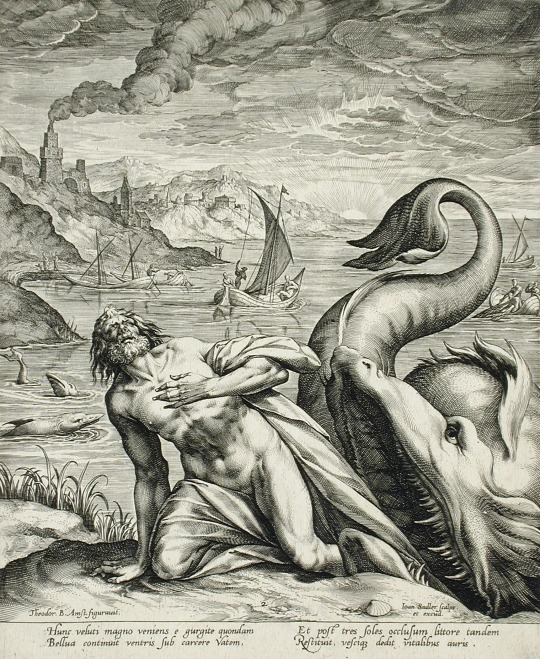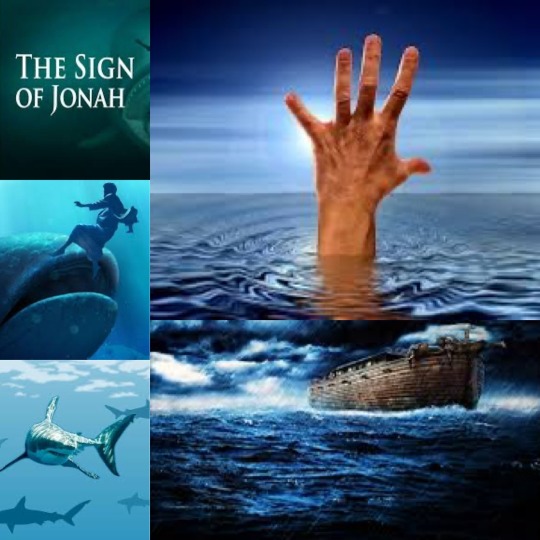#Jonah and the Whale
Explore tagged Tumblr posts
Text
My parents told me about that this very evening!
It's like a really terrible Pinnochio!

Or like a very quick Jonah story.
Or that Rudyard Kipling story where you mustn't forget the suspenders.
welp. it was bound to happen at some point. looks like the whale was feeding and nabbed the guy by accident, and immediately spit him out:
#whale#humpback whale#the guardian#guy eaten by whale#pinnochio#jonah and the whale#how the whale got his throat
17K notes
·
View notes
Text

jonah and the whale 🐋 a series of rooms by aj barlowe
#a series of rooms#aj barlowe#jonah prince#fanart#digital art#procreate#if you like aftg pls read this#jonah and the whale
54 notes
·
View notes
Text

Jonah Spat Up by the Whale, Jan Sadeler, ca. 1582
#art#art history#Jan Sadeler#print#engraving#religious art#Biblical art#Christian art#Old Testament#Hebrew Bible#Book of Jonah#Jonah and the Whale#Baroque#Baroque art#Flemish Baroque#Flemish art#16th century art#Los Angeles County Museum of Art#lacma#lacmamuseum
250 notes
·
View notes
Text

The Exandrian version of Jonah and the Whale
#critical role#critrole#critrole memes#bells hells#bell's hells#imogen temult#predathos#jonah and the whale#cr spoilers#cr memes#cr shitpost#courtesy of me#cr campaign three#crit role#critrole meme#cr3#cr c3
22 notes
·
View notes
Text

Was this an escape fantasy to you, Jonah?
#my art#religious trauma#religious imagery#fish#artists on tumblr#jonah and the whale#character from my comic#which should hopefully be done this year#and by that i mean i should start instead of sitting around
17 notes
·
View notes
Text

James Tissot (1836-1902, French) ~ Jonah, 1896-1902
[Source: artvee.com]
128 notes
·
View notes
Text


2002 Big Idea Veggie Tales Jonah and the Whale Puppet Plush
17 notes
·
View notes
Text
We don’t have to understand everything God is doing in order to trust Him.
#heart posture#love#biblejournaling#jonah and the whale#minor prophets#healingjourney#words of affirmation#tumblr fyp#fyp#mercy#anger#peaceofmind#god is peace#inner peace#motivational speech#relationships quotes#bible journaling#understanding#equality#good news
7 notes
·
View notes
Text


#jonah 2:2#book of jonah#christian#christianity#bible verse#bible scripture#bible#christian blog#christian aesthetic#jonah and the whale
10 notes
·
View notes
Text

Annotating and analysing ‘Introduction Jonah To The Whale’ by Everybody’s Worried About Owen
8 notes
·
View notes
Text

6 notes
·
View notes
Text


Salvador Dalí (1904-1989) Jonah and the whale from the Biblia Sacra, 1975 and 1969, lithography.
2 notes
·
View notes
Text
i’ve just made a rather startling discovery which is that the beginning of the great war by taylor swift sounds almost exactly like the beginning of the credits song from veggie tales jonah and the whale
#taylor swift#veggie tales#veggietales#jonah and the whale#the great war#music#music similarities#random similarities#edmundpevensiesqueen
3 notes
·
View notes
Text
Running Away from God
This past week in the Daily Audio Bible, we read the book and story of Jonah, the reluctant and annoyed prophet of God. It’s a famous story and a short book, so I won’t recap it here. Also, there are many nuggets in this story, but for the sake of brevity, I’ll focus on 3 key points. You Can’t Run from God God directs Jonah to go to Nineveh, the capitol city of the Assyrian empire–the bitter…
View On WordPress
#Advent#God Wants to save everyone#God Will Still save you#Jonah and the whale#You can&039;t run from God
2 notes
·
View notes
Text

Richard Eurich (1903-1992, British) ~ Jonah and the Whale, 1980
[Source: Christie's]
73 notes
·
View notes
Text

The Sign of Jonah: Christ’s Death at Sea
By Eli Kittim
Jonah is the English form of the Hebrew name Yona, which is rendered as Ionas in the Greek. The Ionians were the ancient Greeks (see Josephus Antiquities I, 6). So Ionia means Greece, and an ancient citizen of Ion was called Ionas. So Jonah (Ionas), who is a type of Christ, is depicted as a Greek figure. Let us not forget that Jonah was going to Tarshish, which has been identified as Ancient Greece (see the undermentioned article).
What is more, it seems as if the sign of Jonah is a typological metaphor for Christ’s death and resurrection that is employed by the evangelists in order to demonstrate that Jesus is the Messiah. But, as I will show, it also represents an event in prophetic history, although this has not as yet taken place. In the gospel narrative, Matthew connects Jesus’ death to that of Jonah, after the latter’s body was cast into the sea. Matthew 12:39-40 (NASB) reads thusly:
“An evil and adulterous generation craves a
sign; and so no sign will be given to it except
the sign of Jonah the prophet; for just as
Jonah was in the stomach of the sea
monster for three days and three nights, so
will the Son of Man be in the heart of the
earth for three days and three nights.”
We find analogous parallels and motifs in the Psalms as well. For example, Psalm 69:1-2 reads:
“Save me, God, For the waters have
threatened my life. I have sunk in deep mud,
and there is no foothold; I have come into
deep waters, and a flood overflows me.”
Similarly, Psalm 18:16 says:
“He sent from on high, He took me;
He drew me out of many waters.”
Ephesians 4:9 says that Jesus “descended into the lower parts of the earth.” That is, he descended to the ocean floor. The average depth of the ocean floor is approximately 12,000 feet. So, Matthew is drawing comparative conclusions between Jonah’s and Jesus's death at sea. Let’s see what happened to Jonah. Jonah 1:15-17 says:
“So they picked up Jonah and hurled him
into the sea, and the sea stopped its raging.
… And the Lord designated a great fish to
swallow Jonah, and Jonah was in the
stomach of the fish for three days and three
nights.”
The typological sign of the resurrection is suggested in Jonah 2:10:
“Then the Lord commanded the fish, and it
vomited Jonah up onto the dry land.”
This, then, is the sign of Jonah——which says in effect that God literally “drew … [him] out of many waters”——that Matthew applies to Jesus (cf. Isaiah 43:2)! This is reminiscent of another messianic type who was named “Moses” by Pharaoh's daughter “because … [she] drew him out of the water” (Exod. 2:10). It is also the sign of Jesus’ resurrection from the dead. I will not focus on the phrase “three days and three nights” because it will divert us from the topic at hand. Suffice it to say that it need not refer to a literal three-day period. It seems to be a figure of speech that may signify the three-year great tribulation period.
At any rate, the so-called “sign of Jonah” is not simply a metaphor or a unique sign that would establish the deity of Christ, but it is also a factual event! And although I agree with C.S. Lewis who held that Jonah is ahistorical, nevertheless, I believe that the sign of Jonah, as a type, represents the literal, actual death of its antitype: the Messiah! We know that Jonah did not survive. The Book of Jonah 2:2-6 explicitly says that Jonah, after being hurled into the sea, cried out to God “from the depth of Sheol”:
“I called out of my distress to the Lord, And
He answered me. I called for help from the
depth of Sheol; You heard my voice. For You
threw me into the deep, Into the heart of the
seas, And the current flowed around me. All
Your breakers and waves passed over me.
So I said, ‘I have been cast out of Your
sight.’ … Water encompassed me to the
point of death. The deep flowed around me,
Seaweed was wrapped around my head. …
But You have brought up my life from the
pit, Lord my God.”
It’s important to note that the terms “pit” and “Sheol,” in the Hebrew Bible, are references to the realm of the dead (see e.g. Job 7:9; Ps. 49:14-15; 89:48). The resurrection is depicted in Jonah’s own words: “You have brought up my life from the pit, Lord my God.”
So it appears as if the sign of Jonah is also the sign of Christ’s death. Just as Tim Mackie (co-founder of the Bibleproject) explains in one of his sessions that there is a literary redundancy of the word “hurled” in the Jonah text, especially regarding its main character Jonah who is literally “hurled” into the water, I believe that Christ is similarly “hurled” into the water and eaten by a shark. Hence the symbolism of being born in a manger or a feeding trough. This, of course, is closely related to the last supper (i.e. the sacrament of the Eucharist), the idea that Jesus is literally consumed. There are also overtones of Noah's flood in this parallel (cf. Matthew 24:37), as well as of Osiris, who also drowned and whose coffin (like the Ark) floated in the sea (cf. the story of Perseus who was also cast into the sea in a wooden chest).
Another key point is that, according to the Hebrew text, Jonah's fish is not a whale but rather some kind of “great fish". Through special revelation, this appears to be a shark. And the term “swallow”——in the clause, “the Lord designated a great fish to swallow Jonah”——is a euphemism for a great fish feasting on Jonah and consequently fatally injuring him. This, of course, ties in with the idea that we die and are reborn by going under water (Immersion baptism), a symbolic ritual that is unique to Christianity! Hence why Immersion baptism is not only tied to Jonah but is also symbolic of Christ’s death, being re-enacted in the New Testament through the baptism of Jesus by John the Baptist!
This study of Jonah takes us back to the origin of the Christian fish symbol, the so-called “ichthys” (ἰχθύς), which is now known as the Jesus fish. And despite the acrostic use of this word: Ἰησοῦς Χριστός, Θεοῦ Υἱός, Σωτήρ (i.e. Jesus Christ, Son of God, Saviour)—— nevertheless, the fish symbolism has a variety of other theological overtones in the New Testament, such as the Feeding of the 5,000 with 2 fishes and 5 loaves, as well as the Feeding of the 4,000 with seven loaves of bread and a few small fish, not to mention that Jesus calls his disciples "fishers of men." That is precisely why Immersion baptism in the early church signified a parallel between fish and converts (i.e. born again Christians). The early Christian theologian Tertullian explained it thusly:
“we, little fishes, after the image of our
Ichthys, Jesus Christ, are born in the water."
#signofJonah#Ionas#Noahsflood#GreekMessiah#Tarshish#DeathatSea#ΕλιΚιτιμ#deathandresurrection#ichthys#ΤοΜικροΒιβλιοΤηςΑποκαλυψης#Sheol#jonah and the whale#the little book of revelation#ἰχθύς#Feedingofthe5000#last supper#eatenbysharks#fishers of men#bornagainChristians#eucharist#Immersionbaptism#shark attack#pit#baptismofJesus#Mass#bible project#EliKittim#tertullian#ek#Biblicalinterpretation
3 notes
·
View notes